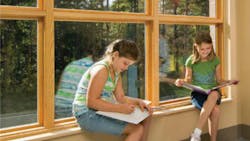Glazing can be optimized to enhance passive solar heating and daylight harvesting by exceeding the prescriptive limits of the energy code (ASHRAE 90.1-2007). This savings can be garnered without the high cost of external overhangs or expensive glazing products.
For most education facilities in Climate Zones 5A-7A, low cooling demands preclude considerations to air-condition classroom spaces, especially when the academic year is nine months. Paradoxically, in order to take advantage of solar glazing, the energy code requires all buildings exceeding the prescriptive requirements to be evaluated as heated and cooled — even when no cooling system exists. Nevertheless, solar glazing may be permitted according to the evaluation criteria, because the energy savings from passive solar heating and daylighting outweigh the cost to cool the additional heat gains during the summer.
Prescriptive Solar Heat Gain Coefficients by Climate Zone
Another paradox is that the energy code does not recognize the use of standard interior shades in the required evaluation method. This omission does not recognize the important role occupants play in regulating their environment for comfort, or their corresponding effects on building energy consumption.
For example, when shades are deployed to control glare, the potential energy cost savings from passive solar heating and daylight harvesting are reduced. Also, when shades are deployed to control unwanted solar gain, they reflect solar radiation, thereby reducing the cooling load. A more realistic evaluation follows that not only considers occupants' preferences to control comfort conditions, but also evaluates the savings for heated-only instructional spaces.
The annual energy cost savings for heated-only spaces of high-solar-gain glass, compared with low-solar-gain glazing, can be significant. When considered for code compliance, solar glazing is permitted in Zones 5A, 6A and 7A because the annual energy costs for a heated/cooled building can be less; this is especially true where the majority of classrooms have exterior walls facing north and south.
The complex interrelation of occupant use, building components and the climate is best evaluated using whole building energy modeling. This not only is necessary for evaluating tradeoffs in the energy code, but also may provide a sensible estimate of energy cost savings.
Building Configuration Assumptions
Instructional spaces are arranged in a typical double-loaded corridor configuration with two equal-sized classrooms (860 square feet each) on each side of a corridor. In each classroom, four small windows are positioned above four larger view windows. The top window is adjacent to the ceiling. Total window-to-wall area is 17 percent.
Heating, ventilating and air-conditioning systems (HVAC) for each classroom space have been assigned energy-code baseline specifications.
A daylight sensor controls half of each classroom's electric lighting. This sensor point measures illumination of daylight and glare. The control simulates continuously dimmable lighting down to a minimum of 30 percent of the input power. The minimum classroom illumination level is 50 footcandles.
The two glazing types selected for this comparison are considered equal in cost (6mm standard clear float glass) and differ in the solar gain and visible light values and position of the low-emissivity (low-e) coating. Other options, at a greater cost, would include low-iron glass for increased visible light transmittance and use of a better insulating gas, such as argon, in lieu of air.
Glass Type 1 and Glass Type 2 both have low-e coatings within the insulating air cavity. However, the low-e coating for low-solar-gain is on the outer pane of glass (surface #2), and high-solar-gain is on the inner pane of glass (surface #3). Furthermore, the spectral properties of the low-e coatings are such that the high-solar-gain type admits more visible light wavelengths and near-infrared radiation.
Shades are scheduled for all south-, east- and west-facing classrooms. Properties are assumed for generic light-colored roller shades that reduce solar heat gain by 40 percent and transmit 23 percnt of daylight.
Occupant uses of interior shades are programmed to control glare and unwanted solar gain during the shoulder cooling season. When glare is high, the model simulates the closing of shades until the glare index is acceptable. Between May and October when solar radiation is undesirable, shades are deployed when solar radiation incident on the windows is too high. During the dominant heating season (November to April), shades controls are based on glare alone. Once deployed, the probability that the shades would be reopened is assumed to be 50 percent during occupied hours and zero when unoccupied.
The assumed occupant shade control preferences effectively reduce unwanted solar gains, with only a 1°F difference between low-solar-gain and high-solar-gain glazing for south-facing classrooms. Figure 1 (above) illustrates the room temperatures for south-facing classrooms in Albany, N.Y., having low-solar-gain glazing (GT1) or high-solar-gain glazing (GT2) and outside air temperature during the few warm days of May.
Solar savings
The majority of savings from solar glazing are attributable to the increase in solar heating and secondarily to daylight illumination.
Spaces with exterior walls/fenestration facing north-south have greater savings than those facing east-west — regardless if conditioned as heated-only or heated/cooled.
Solar glazing may be permissible according to the energy code (ASHRAE 90.1-2007) tradeoff evaluation method in Climate Zones 5A, 6A and 7A because the energy cost savings from passive solar heating may outweigh the cost to air-condition for both nine-month and 12-month academic schedules. However, solar glazing would be permitted in Climate Zone 5A only when the area of fenestration facing north-south is 75 percent of the total and those facing east-west is 25 percent or less.
For a facility with 30 classrooms, a 25-year life-cycle simple cost savings would be $16,000 to $26,000, with no additional cost for specifying a high-solar-gain glazing. For an individual facility, this savings may appear small, but it is significant when considered collectively for the broader geographical region.
Smith, AIA, is an associate with CSArch Architecture | Engineering | Construction Management, a multidisciplinary firm in New York specializing in K-12 and higher-education planning and design.
